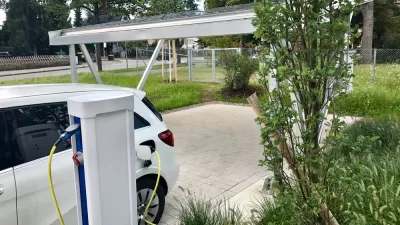Planners can expect changes in the energy industry to influence preparations for the future of cities and communities.

With 2020 is in its early stages, now is an ideal time to take a look at trends that will likely shape this year and have a prolonged impact in the future. Here's an examination of energy infrastructure predictions that could affect other kinds of infrastructures and influence city planning.
1. A Solar Energy Boom Will Begin
In 2019, the Solar Energy Industry Association (SEIA) called 2020-2030 the Solar+ Decade. It also laid out a plan for producing 20% of U.S. electricity with solar power, although it accounts for only 2.4% now. Solar will not see its full potential this year, but one of the energy industry's prominent changes for 2020 is exponential growth in specific regions of the United States.
For example, California mandated that almost all homes built from 2020 onward must get at least some of their power from the sun. City planners in the state must be aware of this new development, and professionals working elsewhere should keep an eye on the possibility of state legislators elsewhere approving similar regulations.
2. Utility Providers Will Assist With Creating Smarter, Cleaner Cities
Savvy developers are aware of the profitable demand in the energy industry to push boundaries and create more innovative energy solutions. For example, many buildings have built-in eco-friendly aspects so people won't have to retrofit them later. Also, many garbage management companies put sensors on receptacles, enabling maintenance crews to get real-time alerts about when to empty them.
A selection of 2020 predictions from Deloitte mentions that utility providers won't want to get left behind as "smart city" innovations gain momentum. Many of them will actively search for and seize opportunities to work alongside municipal planning teams to bring ideas to life.
The Deloitte coverage also discusses how many utility providers have already aided the installation of smart grid infrastructures and meters. However, many utilities will move beyond these initial steps and use their expertise to contribute to other smart city projects, such as car charging stations and solar parking canopies.
3. Oil and Gas Companies Will Continue Digital Transformations
The United States is forecast to provide 70% of the rise in global oil production and 75% of the increase in natural gas by 2024. Keeping pace with this increased oil supply requires making significant alterations, some of which are already underway. One of the most substantial changes in the energy industry for 2020 relates to digital transformation.
The oil and gas industry has historically lagged regarding its willingness to embrace digital transformation options. However, as evidence shows that digitizing operations can save money and avoid downtime, many entities in the sector realize there is no time to waste.
For example, failing to use compiled data for decision-making could cut into revenues. Companies recognize a digital transformation is profitable and relevant.
In smart cities, some digital initiatives for the gas sector have improved customer safety and provided more visibility into overall usage. Multiple options allow for real-time and continuous corrosion monitoring. As the oil and gas field keeps moving forward into the technological era, city officials will have more chances to collaborate with businesses and evaluate how high-tech solutions can help all parties involved.
4. Geopolitical Risks Could Create Supply Shortages
Analysts believe there is a "probable" threat of attacks against energy infrastructure due to escalated tension between the United States and the Middle East. They released this information shortly after U.S. forces killed Qasem Soleimani, a top Iranian general, and Iran retaliated by striking a U.S. military base. Although the situation is now simmering, it's still possible that tempers could flare, and destructive actions may occur.
If this happens, oil prices will rise, and people might stop ignoring the escalating tensions. Even before Soleimani's death, the oil markets persistently ignored the tensions in the Middle East and often wrote off incidents as isolated happenings. Reducing U.S. dependency on foreign oil during a potential supply shortage will not be a quick process, but it can and should be a matter of importance in 2020.
As a result, utility companies bidding on and winning smart city contracts could become even more prominent. One of the top reasons why utility suppliers partner with smart city teams is to boost their revenue, but achieving more electricity independence can be another positive outcome to anticipate.
5. Fossil Fuels Will Remain Dominant Even as Renewables Gain Momentum
2020 will likely be a year when renewable energy sources grab a larger share of the market, but not enough to upset fossil fuel dominance.
Although coal production is down, oil and gas manufacturing levels have gone up, according to the Pew Research Center. The organization also noted that although solar power experienced the most substantial percentage growth of all renewables, it still accounts for only a tiny portion of the market.
Hydropower is the biggest renewable power source in the United States, as the Pew Research Center data showed. However, it still only comprises 2.8% of the market, which is far less than any fossil fuel.
City planners should keep this fact in mind as they launch new projects or work on existing ones. There's certainly no harm in using renewables in municipalities, but people should not expect renewables to surpass fossil fuels anytime soon.
Energy Industry Predictions Worth Studying
Any changes in the energy industry for 2020 could have a ripple effect on other kinds of infrastructure. City planners, infrastructure developers and similar professionals should remain aware of what happens in this sector and ponder what those developments might mean for their work.

Maui's Vacation Rental Debate Turns Ugly
Verbal attacks, misinformation campaigns and fistfights plague a high-stakes debate to convert thousands of vacation rentals into long-term housing.

Planetizen Federal Action Tracker
A weekly monitor of how Trump’s orders and actions are impacting planners and planning in America.

In Urban Planning, AI Prompting Could be the New Design Thinking
Creativity has long been key to great urban design. What if we see AI as our new creative partner?

Portland Raises Parking Fees to Pay for Street Maintenance
The city is struggling to bridge a massive budget gap at the Bureau of Transportation, which largely depleted its reserves during the Civd-19 pandemic.

Spokane Mayor Introduces Housing Reforms Package
Mayor Lisa Brown’s proposals include deferring or waiving some development fees to encourage more affordable housing development.

Houston Mayor Kills Another Bike Lane
The mayor rejected a proposed bike lane in the Montrose district in keeping with his pledge to maintain car lanes.
Urban Design for Planners 1: Software Tools
This six-course series explores essential urban design concepts using open source software and equips planners with the tools they need to participate fully in the urban design process.
Planning for Universal Design
Learn the tools for implementing Universal Design in planning regulations.
Gallatin County Department of Planning & Community Development
Heyer Gruel & Associates PA
JM Goldson LLC
City of Camden Redevelopment Agency
City of Astoria
Transportation Research & Education Center (TREC) at Portland State University
Jefferson Parish Government
Camden Redevelopment Agency
City of Claremont






























